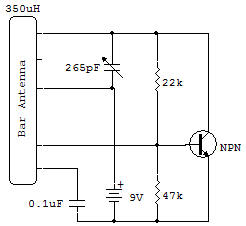
Metal Detector

This project is a demonstration of a metal detector that uses the proximity of metal to the coil of an oscillator to change the frequency of the oscillator and therefore indicate the presence of metal. These types of metal detectors have been used by people to locate lost treasures, buried pipes, hidden land mines and much more.
During war time especially these have been used to save many lives by locating mines and booby traps set out by the enemy. This circuit is a low distortion oscillator that draws only one milliamp from the 9V Battery. Low power is desirable in order to allow the nearby metal to have maximum affect on oscillation frequency.
Use a small transistor radio tuned to a weak AM broadcast station as the detector for this oscillator signal. Tune this oscillator until a low-frequency beat-note is heard. This beat-note is the difference between the broadcast station signal and this oscillator signal. The radio should not be brought any closer to this oscillator than necessary so that the levels of the two signals (the radio station and this oscillator) are about equal at the radio.
This gives maximum sensitivity. Try using keys, plastic objects, coins, etc. as samples of what to expect when using a metal detector like this. Of course a real metal detector does not have a small ferrite coil like this. It is usually an air core coil which is shielded with an aluminum electrostatic shield called a "Faraday electrostatic shield". This project at least gets the point across.
Note:
In case this oscillator will not oscillate no matter what checking you have done to insure proper circuit hook-up, try reversing the lead connections on terminals of L2 coil in the bottom of schematic. If this cures the trouble, reverse the wire connections underneath the board so that proper terminals can be used for this and other projects which require this "phased" connection.
